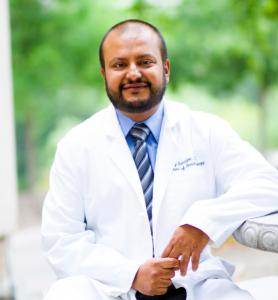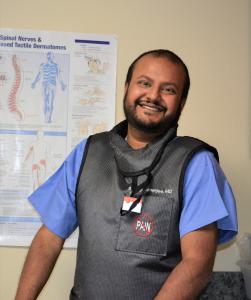In a new article, Dr. Sanjoy Banerjee, focusing on pain management, reviews suboxone treatment for opioid use disorder
Pain management with medications is important to patients’ well-being, but opioid misuse has reached epidemic proportions. Dr. Sanjoy Banerjee provides insight.
While many doctors prescribe opioids for pain, relatively few doctors prescribe buprenorphine medication-assisted therapy (MAT). Buprenorphine, combined with naloxone in the drug Suboxone, is an effective treatment for opioid use disorder and may help people reduce or even quit their use of heroin or other opiates. It was approved for clinical use in 2002 by the Food and Drug Administration (FDA), and is one of the recent advances in MAT. The FDA has approved several buprenorphine products, including Bunavail (buprenorphine and naloxone), and Suboxone (buprenorphine and naloxone).
Opioid use disorder has brought enormous suffering for many people. A treatment with buprenorphine can in many cases be transformative. It allows them to focus on recovering and restoring their place in society.
Dr. Sanjoy Banerjee, who focuses on Pain Management, shares his thoughts in a new article, which is available on his blog at https://sanjoybanerjeemd.home.blog/
At the heart of the matter is the problem of addiction. In very simple terms, addiction is a brain condition with a genetic component that affects a person’s motivation, inhibition, and cognition. When a person is affected by such addiction, MAT with buprenorphine may be as effective as methadone in terms of treatment continuation and decreased opioid use. However, medications such as buprenorphine should be combined with counseling and behavioral therapies for a complete “mind and body” approach for the treatment of opioid dependency.
During such a treatment, the doctor should document any relapses, order urine drug testing, check the pill or wrapper counts, and check state prescription drug database records.
How does the treatment work?
Buprenorphine is an “opioid partial agonist.” In layman’s terms, it produces effects such as euphoria or respiratory depression. Compared to other substances such as methadone and heroin, however, buprenorphine effects are weaker. One of the advantages of buprenorphine is that its opioid effects increase with each dose until at moderate doses they level off. This is called “ceiling effect” and lowers the risk of misuse and side effects.
Side Effects
As with many medications, buprenorphine has side effects, even under medical supervision. They may include:
* Nausea
* Muscle pain
* Sleep problems
* Irritability
And because buprenorphine has opioid effects, there is the potential for misuse.
Precautions
As with all medications, patients should take precautions when using them, including:
- Medical supervision
- Consulting with their doctor before taking other medications
- Not using alcohol or other drugs such as tranquilizers or sedatives
Buprenorphine is not for everybody. While this treatment may be beneficial, it is certainly not for everybody. The doctor will review whether the patient:
- Has been positively diagnosed with an opioid dependency
- Will be able to follow any safety precautions
- Does not have health issues that interfere with the treatment
The doctor will also review possible alternative treatments, and put special data safeguards in place. Information related to substance use and alcohol treatment is handled with a high degree of confidentiality.
Misconceptions
Finally, there are many misconceptions about this treatment, such as that it just substitutes for another. However, intoxication from Suboxone does not occur if a patient is opioid dependent. Such occurs only in patients who combine Suboxone with other substances, or do not follow instructions, or use it for withdrawal. Doctors can help prevent misuse with appropriate monitoring, urine drug testing, and film or pill counts.
In conclusion, buprenorphine is an underutilized treatment for opioid use disorder. With additional training of more doctors and information to the public, it may become an effective measure to control the opioid epidemic.
Dr. Sanjoy Banerjee, M.D., QME (Corona & Wildomar, California)
Dr. Sanjoy Banerjee is the Founder and Medical Director of Pacific Pain Care in Corona and Wildomar, California. He graduated medical school from Imperial College, School of Medicine in London, England, and completed his Anesthesiology Residency at the University of Rochester, New York. In addition, Dr. Banerjee completed the ACGME accredited Pain Management Fellowship Program at the University of California at Davis.
References
Website: http://www.pacificpaincare.com/doctors
Blog: https://sanjoybanerjeemd.home.blog/
Blog of Pacific Pain Care: https://www.pacificpaincare.com/blog
News: https://medicogazette.com/dr-sanjoy-banerjee
News: https://hype.news/dr-sanjoy-banerjee/
News: https://hippocratesguild.com/dr-sanjoy-banerjee
LinkedIn: https://www.linkedin.com/in/sanjoy-banerjee-a57079186/
Doctor Profile: https://www.vitals.com/doctors/Dr_Sanjoy_Banerjee.html
Article on LinkedIn: https://www.linkedin.com/pulse/medical-doctor-dr-sanjoy-banerjee-starts-blog-pain-related-banerjee
Youtube: https://www.youtube.com/user/PacificPainCare
Facebook: https://www.facebook.com/Pacific-Pain-Care-1751511985128467/
Other professional references:
https://pdfs.semanticscholar.org/4e70/5b427db75d9402d96d2f8398e9d9cc2f055e.pdf
http://cancercenter.ucdavis.edu/pain/Pain%20Resources/QinterstitialCystitis_Banerjee.pdf
https://www.ncbi.nlm.nih.gov/pubmed/20718649#
https://www.tandfonline.com/doi/abs/10.3109/15360288.2010.503985
https://medschool.ucr.edu/community-based-faculty
http://www.llu.edu/pages/faculty/directory/index2.html?dept=Medicine
Dr. Sanjoy Banerjee
Pacific Pain Care
+1 855-854-7246
email us here
Visit us on social media:
Facebook
LinkedIn
Dr. Sanjoy Banerjee, Pacific Pain Care - Post stroke pain Testimonial.
Legal Disclaimer:
EIN Presswire provides this news content "as is" without warranty of any kind. We do not accept any responsibility or liability for the accuracy, content, images, videos, licenses, completeness, legality, or reliability of the information contained in this article. If you have any complaints or copyright issues related to this article, kindly contact the author above.





